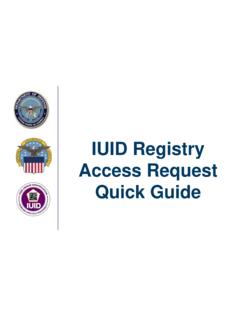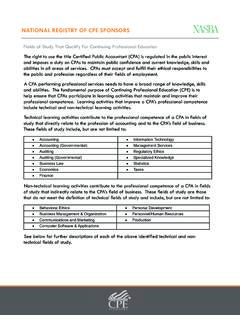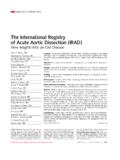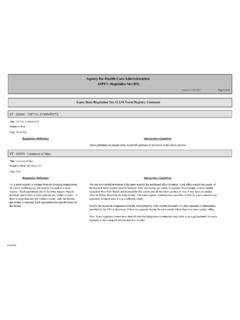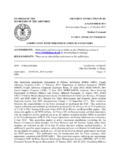Transcription of Introduction to UDDI: Important Features and Functional ...
1 Introduction to uddi : Important Features and Functional Concepts October 2004. Organization for the Advancement of Structured Information Standards Introduction to uddi . Important Features and Functional Concepts TABLE OF CONTENTS. TYPICAL APPLICATIONS OF A uddi 4. A BRIEF HISTORY OF 4. KEY Functional CONCEPTS IN THE uddi The uddi Data Model De ning uddi Nodes, Registries, and A liated Registries Essential Programmatic Interfaces in uddi . uddi VERSION 3: A FOCUS ON PRIVATE REGISTRIES AND. REGISTRY 9. A Closer Look at Registry A liation HOW TO LEARN 11. Page 2. Introduction to uddi . Important Features and Functional Concepts OVERVIEW. The Universal Description, Discovery, and Integration ( ) protocol is a central element of the group of related standards that comprise the Web services stack.
2 The speci cation de nes a standard method for publishing and discovering the network-based software components of a service-oriented architecture ( ). Its development is led by the consortium of enterprise software vendors and customers. This paper provides a concise overview of the standard and highlights signi cant architectural changes in the recent Version 3 speci cation. In a companion white paper, we describe business scenarios that and related Web services infrastructure are well suited to help address. TYPICAL APPLICATIONS OF A uddi REGISTRY. A registry's Functional purpose is the representation of data and metadata about Web services. A registry, either for use on a public network or within an organization's internal infrastructure, o ers a standards-based mechanism to classify, catalog, and manage Web services, so that they can be discovered and consumed by other applications.
3 As part of a generalized strategy of indirection among services- based applications, o ers several bene ts to IT managers at both design-time and run-time, including increasing code re-use and improving infrastructure management by: Publishing information about Web services and categorization rules speci c to an organization Finding Web services (within an organization or across organizational boundaries) that meet given criteria Determining the security and transport protocols supported by a given Web service and the parameters necessary to invoke the service Providing a means to insulate applications (and providing fail-over and intelligent routing) from failures or changes in invoked services A BRIEF HISTORY OF uddi . When rst was conceived, much of the attention was focused on the . Page 3.
4 Introduction to uddi . Important Features and Functional Concepts Business Registry ( ), a public implementation of the standard that represented a master directory of publicly available e-commerce services. In many ways, this public registry can be considered analogous to the root node of the . database, another successful example of a distributed registry infrastructure. Although the remains an Important part of the project, it represents only one aspect of the overall e ort. Just as the overwhelming majority of activity occurs within the con nes of a company's own network, so too do most . implementations support a business' own Web services infrastructure. This understanding is re ected as the speci cation has evolved to re ect the need for federated control in real-world operational requirements, as well as to further integrate the standard with other elements of service-oriented infrastructure.
5 Highlights of the standard's progress are shown in the table below. Figure 1: History of the uddi Speci cation uddi VERSION YEAR RELEASED KEY OBJECTIVE. Create foundation for registry of Internet- 2000. based business services Align speci cation with emerging Web services standards and provide exible 2001. service taxonomy. Formally released under aegis in 2003. Support secure interaction of private and public implementations as major 2004 element of service-oriented infrastructure. To be released by in late 2004. The current speci cation represents a signi cant milestone in 's evolution. Its feature de nitions are stable and backwards-compatible with earlier versions of the standard. In fact, a prerequisite of its certi cation by standards group was the existence of several working commercial implementations.
6 We examine major Functional Features of in more detail, below. Page 4. Introduction to uddi . Important Features and Functional Concepts KEY Functional CONCEPTS IN THE uddi SPECIFICATION. describes a registry of Web services and programmatic interfaces for publishing, retrieving, and managing information about services described therein. In fact, itself is of set a Web services! The speci cation de nes services that support the description and discovery of (1) businesses, organizations, and other Web services providers, (2) the Web services they make available, and (3) the technical interfaces which may be used to access and manage those services. is based upon several other established industry standards, including , , Schema ( ), , and . In this paper, we will highlight several Important technical characteristics of an.
7 Registry, but this introductory discussion necessarily is neither exhaustive nor de nitive. The o cial speci cation formally describes the Web services, data structures, and behaviors of a registry that complies with the standard.*. The uddi Data Model The core information model used by a registry is de ned in several . schemas. was chosen because it o ers a platform-neutral view of data and allows hierarchical relationships to be described in a natural way. was chosen because of its support for rich data types and its ability to easily describe and validate information based on information models represented in schemas. The s de ne several core types of information that provide the kinds of information that that users and applications would need to know in order to use a particular Web service.
8 Together, these form a base information model and interaction framework of registries. They are: A description of a service's business function (called the businessService). Information about the organization that published the service (businessEntity), The service's technical details (bindingTemplate), including a reference to the service's programmatic interface or , and Various other attributes or metadata such as taxonomy, transports, digital * The o cial speci cation can be found online at Several technical notes and best practices documents also are available on this web site. Page 5. Introduction to uddi . Important Features and Functional Concepts signatures, etc. (tModels). Figure 2: uddi 's Core Data Types versions 2 and 3 each add an additional data type to facilitate registry a liation.
9 Respectively, these are: Relationships among entities in the registry (publisherAssertion) and Standing requests to track changes to a list of entities (subscription). These, like all data types, are expressed in and are stored persistently by a registry. Within a registry, each core data structure is assigned a unique identi er according to a standard scheme. This identi er is referred to as a key. Taxonomic Classi cation of uddi Entities An Important part of is providing a foundation and best practices that help provide semantic structure to the information about Web services contained in a registry. allows users to de ne multiple taxonomies that can be used in a registry. In such a way, users are not tied to a single system, but can rather employ an unlimited number of appropriate classi cation systems simultaneously.
10 Also de nes a consistent way for a publisher to add new classi cation schemes to their registrations. Page 6. Introduction to uddi . Important Features and Functional Concepts De ning uddi Nodes, Registries, and A liated Registries The speci cation includes a speci c de nition of the hierarchical relationship between a single instance of a implementation and others to which it is related. Technically, there are three major classi cations of servers: A node is a server that supports at least the minimum set of functionality de ned in the speci cation. It may perform one or more functions on the . data to which it has access. It is a member of exactly one registry. A registry is composed of one or more nodes. A registry performs the complete set of functionality as de ned in the speci cation.


